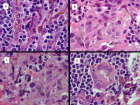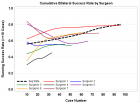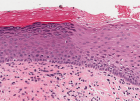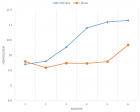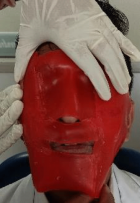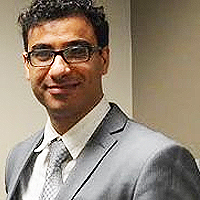Abstract
Research Article
Effect of laparoscopic salpingectomy on subsequent ovarian response after controlled ovarian hyperstimulation
Chadi Yazbeck*, Asma Boukadida, Christian Chauvin, Anne Laure Margulies and Ségolène Falcone
Published: 18 September, 2019 | Volume 2 - Issue 2 | Pages: 107-112
Background: The effect of salpingectomy on ovarian response is a matter of debate. Due to conflicting data, alternative techniques were developed to perform salpingectomy for treatment of hydrosalpinges in infertile patients. This study aims to evaluate the effect of salpingectomy on ovarian response after stimulation with gonadotropins.
Methods: In a retrospective analysis, one hundred fifty-seven patients with tubal infertility were divided into three groups according to their surgical histories: bilateral salpingectomy (BS group); unilateral salpingectomy (US group); and no history of salpingectomy (NS group). Ovarian response and IVF outcomes were compared between groups by analysis of variance. Prognostic factors for ovarian response were estimated by linear regression models.
Results: In the BS group, the total numbers of oocytes retrieved, and embryos obtained were significantly lower than those in the NS group (p = 0.02). Poor ovarian response was also more frequent in the BS group (p = 0.02). In the US group, follicle development was reduced on the operated side. This effect was more pronounced when salpingectomies were performed for hydrosalpinges than when performed for ectopic pregnancies, and significant decreases were observed in follicle recruitment (p = 0.005) and oocyte retrieval (p = 0.02) on the operated side.
Conclusion: Salpingectomy could have a minor negative effect on ovarian response. This is particularly true with bilateral salpingectomies, in which the ovarian blood supply could be disrupted, with no possible compensation by the contralateral side.
Read Full Article HTML DOI: 10.29328/journal.cjog.1001030 Cite this Article Read Full Article PDF
Keywords:
Assisted reproductive technology; Fallopian tubes; Ovarian reserve; Reproductive surgery; Salpingectomy
References
- Dubuisson JB, Morice P, Chapron C, De Gayffier A, Mouelhi T. Salpingectomy - the laparoscopic surgical choice for ectopic pregnancy. Hum Reprod. 1996; 11: 1199-1203. PubMed: https://www.ncbi.nlm.nih.gov/pubmed/8671423
- Andersen AN, Yue Z, Meng FJ, Petersen K. Low implantation rate after in-vitro fertilization in patients with hydrosalpinges diagnosed by ultrasonography. Hum Reprod. 1994; 9: 1935-1938. PubMed: https://www.ncbi.nlm.nih.gov/pubmed/7844229
- Dechaud H. [[Hydrosalpinx and fertilization in vitro-embryo transfer: abstention or salpingectomy? Salpingectomy, yes but when and for whom?]. Gynecol Obstet Fertil. 2001; 29: 473-474. PubMed: https://www.ncbi.nlm.nih.gov/pubmed/11462968
- Katz E, Akman MA, Damewood MD, Garcia JE. Deleterious effect of the presence of hydrosalpinx on implantation and pregnancy rates with in vitro fertilization. Fertil Steril. 1996; 66: 122-125. PubMed: https://www.ncbi.nlm.nih.gov/pubmed/8752622
- Strandell A, Waldenstrom U, Nilsson L, Hamberger L. Hydrosalpinx reduces in-vitro fertilization/embryo transfer pregnancy rates. Hum Reprod. 1994; 9: 861-863. PubMed: https://www.ncbi.nlm.nih.gov/pubmed/7929732
- Vandromme J, Chasse E, Lejeune B, Van Rysselberge M, Delvigne A, et al. Hydrosalpinges in in-vitro fertilization: an unfavourable prognostic feature. Hum Reprod. 1995; 10: 576-579. PubMed: https://www.ncbi.nlm.nih.gov/pubmed/7782435
- Camus E1, Poncelet C, Goffinet F, Wainer B, Merlet F, et al. Pregnancy rates after in-vitro fertilization in cases of tubal infertility with and without hydrosalpinx: a meta-analysis of published comparative studies. Hum Reprod. 1999; 14: 1243-1249. PubMed: https://www.ncbi.nlm.nih.gov/pubmed/10325271
- Zeyneloglu HB, Arici A, Olive DL. Adverse effects of hydrosalpinx on pregnancy rates after in vitro fertilization-embryo transfer. Fertil Steril. 1998; 70: 492-499. PubMed: https://www.ncbi.nlm.nih.gov/pubmed/9757878
- Bredkjaer HE1, Ziebe S, Hamid B, Zhou Y, Loft A, et al. Delivery rates after in-vitro fertilization following bilateral salpingectomy due to hydrosalpinges: a case control study. Hum Reprod. 1999; 14: 101-105. PubMed: https://www.ncbi.nlm.nih.gov/pubmed/10374103
- Strandell A, Lindhard A, Waldenstrom U, Thorburn J, Janson PO, et al. Hydrosalpinx and IVF outcome: a prospective, randomized multicentre trial in Scandinavia on salpingectomy prior to IVF. Hum Reprod. 1999; 14: 2762-2769. PubMed: https://www.ncbi.nlm.nih.gov/pubmed/10548619
- Johnson N, van Voorst S, Sowter MC, Strandell A, Mol BW. Surgical treatment for tubal disease in women due to undergo in vitro fertilisation. Cochrane Database Syst Rev. 2010; CD002125. PubMed: https://www.ncbi.nlm.nih.gov/pubmed/15266464
- Johnson NP, Mak W, Sowter MC. Laparoscopic salpingectomy for women with hydrosalpinges enhances the success of IVF: a Cochrane review. Hum Reprod. 2002; 17: 543-548. PubMed: https://www.ncbi.nlm.nih.gov/pubmed/11870100
- Chan CC, Ng EH, Li CF, Ho PC. Impaired ovarian blood flow and reduced antral follicle count following laparoscopic salpingectomy for ectopic pregnancy. Hum Reprod. 2003; 18: 2175-2180. PubMed: https://www.ncbi.nlm.nih.gov/pubmed/14507841
- Gelbaya TA, Nardo LG, Fitzgerald CT, Horne G, Brison DR, et al. Ovarian response to gonadotropins after laparoscopic salpingectomy or the division of fallopian tubes for hydrosalpinges. Fertil Steril. 2006; 85: 1464-1468. PubMed: https://www.ncbi.nlm.nih.gov/pubmed/16580673
- Lass A1, Ellenbogen A, Croucher C, Trew G, Margara R, et al. Effect of salpingectomy on ovarian response to superovulation in an in vitro fertilization-embryo transfer program. Fertil Steril. 1998; 70: 1035-1038. PubMed: https://www.ncbi.nlm.nih.gov/pubmed/9848291
- Meng XH, Zhu YM. [Effect of salpingectomy on ovarian function]. Zhejiang Da Xue Xue Bao Yi Xue Ban. 2006; 35: 555-559. PubMed: https://www.ncbi.nlm.nih.gov/pubmed/17063552
- Almog B1, Wagman I, Bibi G, Raz Y, Azem F, et al. Effects of salpingectomy on ovarian response in controlled ovarian hyperstimulation for in vitro fertilization: a reappraisal. Fertil Steril. 2011; 95: 2474-2476. PubMed: https://www.ncbi.nlm.nih.gov/pubmed/21474129
- Dar P, Sachs GS, Strassburger D, Bukovsky I, Arieli S. Ovarian function before and after salpingectomy in artificial reproductive technology patients. Hum Reprod. 2000; 15: 142-144. PubMed: https://www.ncbi.nlm.nih.gov/pubmed/10611204
- Kontoravdis A, Makrakis E, Pantos K, Botsis D, Deligeoroglou E, et al. Proximal tubal occlusion and salpingectomy result in similar improvement in in vitro fertilization outcome in patients with hydrosalpinx. Fertil Steril. 2006; 86: 1642-1649. PubMed: https://www.ncbi.nlm.nih.gov/pubmed/17069813
- Strandell A, Lindhard A, Waldenstrom U, Thorburn J. Prophylactic salpingectomy does not impair the ovarian response in IVF treatment. Hum Reprod. 2001; 16: 1135-1139. PubMed: https://www.ncbi.nlm.nih.gov/pubmed/11387282
- Surrey ES, Schoolcraft WB. Laparoscopic management of hydrosalpinges before in vitro fertilization-embryo transfer: salpingectomy versus proximal tubal occlusion. Fertil Steril. 2001; 75: 612-617. PubMed: https://www.ncbi.nlm.nih.gov/pubmed/11239550
- Tal J, Paltieli Y, Korobotchka R, Ziskind G, Eibschitz I, et al. Ovarian response to gonadotropin stimulation in repeated IVF cycles after unilateral salpingectomy. J Assist Reprod Genet. 2002; 19: 451-455. PubMed: https://www.ncbi.nlm.nih.gov/pubmed/12416648
- Verhulst G, Vandersteen N, van Steirteghem AC, Devroey P. Bilateral salpingectomy does not compromise ovarian stimulation in an in-vitro fertilization/embryo transfer programme. Hum Reprod. 1994; 9: 624-628. PubMed: https://www.ncbi.nlm.nih.gov/pubmed/8046013
- Ducarme G, Uzan M, Hugues JN, Cedrin-Durnerin I, Poncelet C. Management of hydrosalpinx before or during in vitro fertilization-embryo transfer: a national postal survey in France. Fertil Steril. 2006; 86: 1013-1016. PubMed: https://www.ncbi.nlm.nih.gov/pubmed/16962113
- Alvarez F, Faundes A, Brache V, Tejada AS, Segal S. Prospective study of the pituitary-ovarian function after tubal sterilization by the Pomeroy or Uchida techniques. Fertil Steril. 1989; 51: 604-608. PubMed: https://www.ncbi.nlm.nih.gov/pubmed/2494079
- Cattanach J. Oestrogen deficiency after tubal ligation. Lancet. 1985; 1: 847-849. PubMed: https://www.ncbi.nlm.nih.gov/pubmed/2858712
- Cattanach JF, Milne BJ. Post-tubal sterilization problems correlated with ovarian steroidogenesis. Contraception. 1988; 38: 541-550. PubMed: https://www.ncbi.nlm.nih.gov/pubmed/3197418
- Radwanska E, Headley SK, Dmowski P. Evaluation of ovarian function after tubal sterilization. J Reprod Med. 1982; 27: 376-384. PubMed: https://www.ncbi.nlm.nih.gov/pubmed/6811740
- Chauvin C, Koskas M, Yazbeck C. [Salpingectomy--how I do it]. Gynecol Obstet Fertil. 2010; 38: 776-777. PubMed: https://www.ncbi.nlm.nih.gov/pubmed/21030283
- Fan M, Ma L. Effect of salpingectomy on ovarian response to hyperstimulation during in vitro fertilization: a meta-analysis; Fertil Steril. 2016; 106: 322-329. PubMed: https://www.ncbi.nlm.nih.gov/pubmed/27114330
- Kotlyar A, Gingold J, Shue S, Falcone T. The Effect of salpingectomy on ovarian function. J Minim Invasive Gynecol. 2017; 24: 563-578. PubMed: https://www.ncbi.nlm.nih.gov/pubmed/28223181
Figures:
Similar Articles
-
Effect of laparoscopic salpingectomy on subsequent ovarian response after controlled ovarian hyperstimulationChadi Yazbeck*,Asma Boukadida,Christian Chauvin,Anne Laure Margulies,Ségolène Falcone. Effect of laparoscopic salpingectomy on subsequent ovarian response after controlled ovarian hyperstimulation. . 2019 doi: 10.29328/journal.cjog.1001030; 2: 107-112
-
Epidemiologic aspects and risk factors associated with infertility in women undergoing assisted reproductive technology (ART) in north of IranMarzieh Zamaniyan,Noushin Gordani*,Paniz Bagheri,Kaveh Jafari,Sepideh Peyvandi,Mojtaba Hajihoseini,Robabeh Taheripanah,Siavash Moradi,Salomeh Peyvandi,Arman Alborzi. Epidemiologic aspects and risk factors associated with infertility in women undergoing assisted reproductive technology (ART) in north of Iran. . 2021 doi: 10.29328/journal.cjog.1001079; 4: 015-018
-
SARS-CoV-2 infection does not affect ovarian reserve in women undergoing assisted reproductionMara Campitiello,María Cruz,Cristina González-Ravina,Vanessa Vergara,Alberto Pacheco,José Remohí,Antonio Requena Miranda*. SARS-CoV-2 infection does not affect ovarian reserve in women undergoing assisted reproduction. . 2023 doi: 10.29328/journal.cjog.1001123; 6: 021-025
Recently Viewed
-
Treatment Outcome in Patients with Myofascial Orofacial Pain: A Randomized Clinical TrialAnders Wänman*, Susanna Marklund, Negin Yekkalam. Treatment Outcome in Patients with Myofascial Orofacial Pain: A Randomized Clinical Trial. J Oral Health Craniofac Sci. 2024: doi: 10.29328/journal.johcs.1001046; 9: 001-008
-
Hygiene and Care Protocols for Implant-supported Dental Prostheses in Patients with DiabetesHakob Khachatryan, Emma Boshnaghyan, Sevak Papoyan, Gagik Hakobyan*. Hygiene and Care Protocols for Implant-supported Dental Prostheses in Patients with Diabetes. J Oral Health Craniofac Sci. 2024: doi: 10.29328/journal.johcs.1001047; 9: 009-014
-
Advancing Oral Health and Craniofacial Science through Microchip ImplantsShekufeh Shafeie*. Advancing Oral Health and Craniofacial Science through Microchip Implants. J Oral Health Craniofac Sci. 2024: doi: 10.29328/journal.johcs.1001048; 9: 015-018
-
Texture Analysis of Hard Tissue Changes after Sinus Lift Surgery with Allograft and XenograftMohammad Azimzadeh, Farzad Esmaeili, Narges Bayat, Kasra Rahimipour, Amir Ebrahimpour Tolouei*. Texture Analysis of Hard Tissue Changes after Sinus Lift Surgery with Allograft and Xenograft. J Oral Health Craniofac Sci. 2024: doi: 10.29328/journal.johcs.1001049; 9: 019-022
-
Awareness and Knowledge of Specialists/Trainers and General Dental Practitioners about Medical-Related Osteonecrosis of the JawsAbdulhamit Taha Koca,Mustafa Bayhan,Yunus Ayberk Demir,Ayse Zeynep Zengin*. Awareness and Knowledge of Specialists/Trainers and General Dental Practitioners about Medical-Related Osteonecrosis of the Jaws. J Oral Health Craniofac Sci. 2024: doi: 10.29328/journal.johcs.1001050; 9: 023-031
Most Viewed
-
Evaluation of Biostimulants Based on Recovered Protein Hydrolysates from Animal By-products as Plant Growth EnhancersH Pérez-Aguilar*, M Lacruz-Asaro, F Arán-Ais. Evaluation of Biostimulants Based on Recovered Protein Hydrolysates from Animal By-products as Plant Growth Enhancers. J Plant Sci Phytopathol. 2023 doi: 10.29328/journal.jpsp.1001104; 7: 042-047
-
Sinonasal Myxoma Extending into the Orbit in a 4-Year Old: A Case PresentationJulian A Purrinos*, Ramzi Younis. Sinonasal Myxoma Extending into the Orbit in a 4-Year Old: A Case Presentation. Arch Case Rep. 2024 doi: 10.29328/journal.acr.1001099; 8: 075-077
-
Feasibility study of magnetic sensing for detecting single-neuron action potentialsDenis Tonini,Kai Wu,Renata Saha,Jian-Ping Wang*. Feasibility study of magnetic sensing for detecting single-neuron action potentials. Ann Biomed Sci Eng. 2022 doi: 10.29328/journal.abse.1001018; 6: 019-029
-
Pediatric Dysgerminoma: Unveiling a Rare Ovarian TumorFaten Limaiem*, Khalil Saffar, Ahmed Halouani. Pediatric Dysgerminoma: Unveiling a Rare Ovarian Tumor. Arch Case Rep. 2024 doi: 10.29328/journal.acr.1001087; 8: 010-013
-
Physical activity can change the physiological and psychological circumstances during COVID-19 pandemic: A narrative reviewKhashayar Maroufi*. Physical activity can change the physiological and psychological circumstances during COVID-19 pandemic: A narrative review. J Sports Med Ther. 2021 doi: 10.29328/journal.jsmt.1001051; 6: 001-007

HSPI: We're glad you're here. Please click "create a new Query" if you are a new visitor to our website and need further information from us.
If you are already a member of our network and need to keep track of any developments regarding a question you have already submitted, click "take me to my Query."








